Living in the countryside allows me the privilege to access some gorgeous fresh produce that otherwise does not make its way to the urban markets. While travels through the rural landscapes and interacting with local communities educates me on the mindful practices the produce is processed and consumed. And fresh Mahuda/Mahua flowers top the list of ‘gorgeous fresh produce’! There is a mature Mahudo/ Madhuca longifolia (tree) on the vacant plot adjoining ours. Come April, and we get to forage and enjoy the fresh Mahuda flowers first thing in the morning along with the peacocks, squirrels, small mini-vets, magpie robins, purple sunbirds, a couple of species of bulbuls, yellow-footed pigeons, laughing doves… and the chorus they create turns into a party at times. We all seem to be in a hurry to eat our day’s quota of intensely sweet, juicy, and aromatic Mahuda flowers and make merry. The adjective sweet is used on purpose because not all Mahuda trees are sweet, and even amongst the sweet trees, there can be slight to significant differences (as Deepa and I got to taste for ourselves on our recent trip to Gujarat’s remote tribal pockets) in the sweetness of the flowers.
The tribal regard Mahuda as Kalp Vriksh/Tree of Life, and their prosperity is also measured by the number of Mahuda trees the family owns. Their faces light up when talking about the Mahuda trees they own. During my numerous interactions with the tribal women from various tribes to learn more about their cultural cuisines and diets, when it comes to Mahuda, there is always a mention of Mahuda ladoo ( I have shared earlier) apart from slurping them sasravine meaning boiled/soup style or make their version of Mahuda Dhokla. Occasionally Sheero/Halwa gets mentioned, although not elaborate as the ghee+flour+sugar sheero/halwa we make. Watching these women cook with minimal kitchen tools and ingredients but supreme confidence is also a revelation. And everything they cook and serve confidently speaks volumes of their minimal lifestyles close to nature and inherent skills of growing, foraging and cooking with native produce.
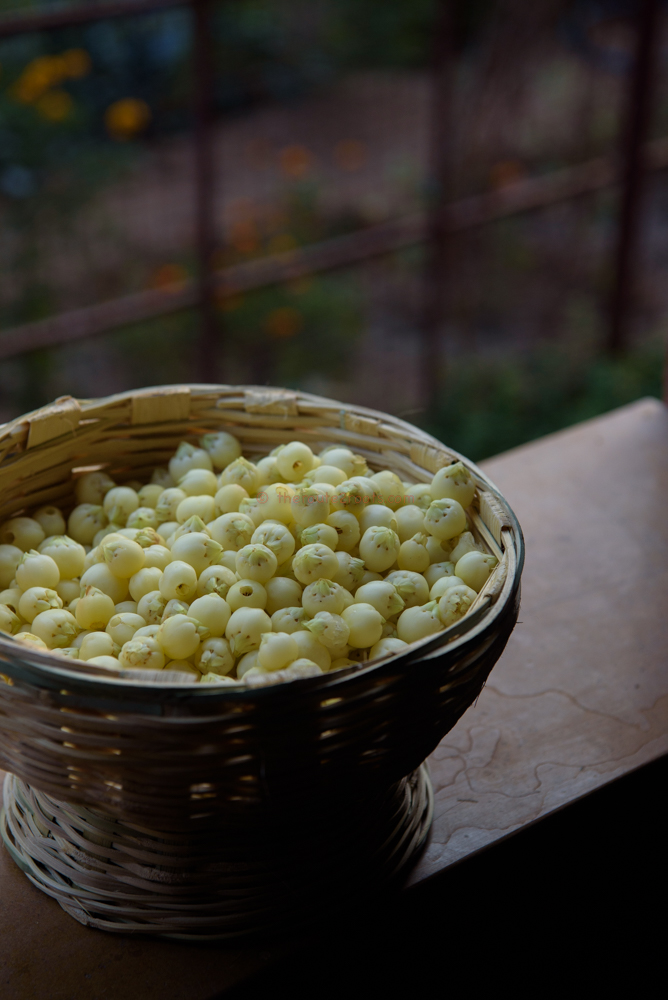
This is the second year we are drenching ourselves in the heady aroma of fresh Mahua flowers, picking them up, and eating a handful in the mornings. For a change, I felt like treating myself to some sheero, Mahuda no Sheero. It was for the first time I was cooking with fresh Mahuda flowers. Hence, I decided to invoke the confidence of numerous tribal women I have observed cooking Mahuda flowers.
With no particular recipe in mind, I proceeded like so… boiled the fresh Mahuda flowers in little water, strained and minced them, took care not to discard sweet and aromatic cooking liquid. Fried the cashews and some dried Mahuda flowers (from last year)in ghee, in the same ghee, roasted a mix of sooji and coarse wheat flour till it turned pale pink, fluffy, and aromatic. Added the minced Mahuda, cooked it so that they both blend well, then hot water that included the Mahuda cooking liquid went into the flour+mahuda mix. Once the water gets absorbed, khandsari/sugar gets incorporated, all of this is stirred well and cooked until the sheero leaves the sides of the tin-coated brass kadai. Fried cashew and Mahuda made it to the sheero as final flourish… If you get lucky to find fresh Mahuda flowers, try making this Sheero. It tastes Divine.
Some Mahuda stories I have covered in past can be accessed here
https://www.instagram.com/p/CeduNAAvN7s/?igshid=YmMyMTA2M2Y=
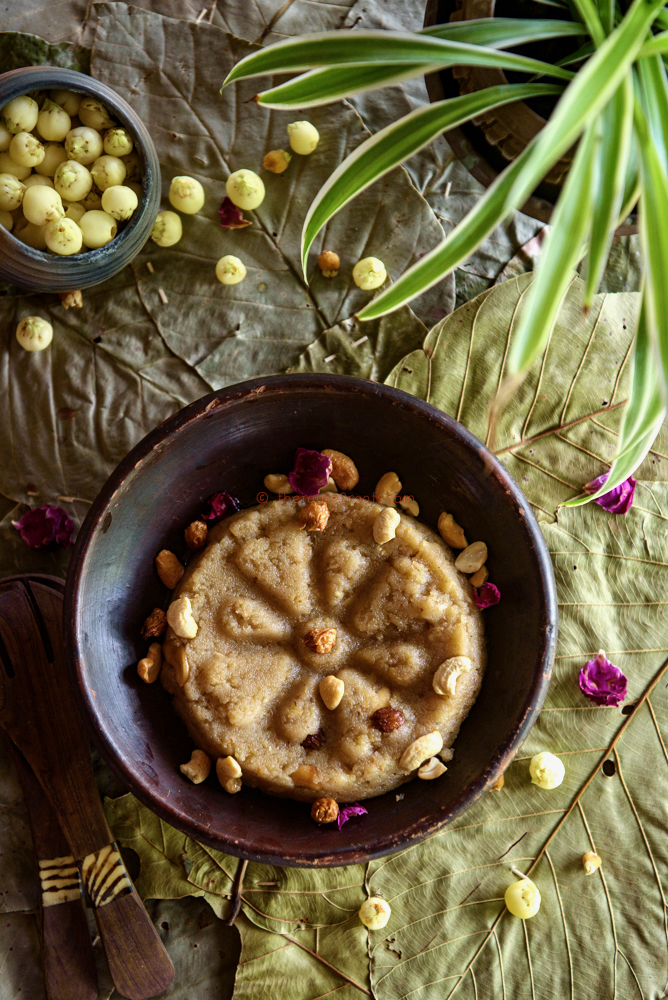
Mahuda na Phool no Sheero
Ingredients
- 3/4 cup fresh Mahuda flowers or 1/2 cup dried Mahuda flowers
- 1/4 cup sooji
- 1/4 cup whole wheat flour, coarsely ground
- 1/3 cup sugar, (adjust according to taste)
- 1.5 cups hot water, I used the Mahuda cooking liquid water
- 1/3 to 1/2 cup ghee, melted
- 1/4 teaspoon green cardamom powder
- 1/4 cup cashew pieces and raisins, I replaced raisins with dried Mahuda flowers.
Instructions
Wash the Mahuda flowers with 2 to 3 water changes.
In a saucepan put the wash and cleaned Mahuda flowers and add enough water to cover them. Cook the flowers till they become are soft to touch.
Scoop the cooked Mahuda flowers and reserve the cooking liquid.
Mince the flowers. Keep aside.
Place a kadai on medium flame.
Add ghee. After the ghee heats up, fry the cashew and raisins/mahuda flowers. Remove and set aside.
Now to the same ghee, add both the flours.
Over a very gentle flame, roast the flours until they turn light pink in colour and begin to emit a very pleasant aroma.
Once the flours have roasted well, add the minced Mahuda flowers. Mix well and cook for 2-3 minutes.
Now add the water, I had one cup of the Mahuda cooking liquid which I have used and balanced the rest with normal water.
Blend it all to a homogenous mix, stir well as it thickens.
Mix in the sugar and continue stirring and cooking till you see ghee being released on the sides.
Keep the flame to minimum, cover and allow it to cook for few minutes. This is an important step.
The sheero will turn crumbly.
Sprinkle the cardamom powder, blend it well.
Turn off the flame, garnish with the final flourish of fried cashews and raisins.
Enjoy while it is still hot.
Notes
Coarsely milled whole wheat flour lends better texture to Sheero, if it is hard to source replace it with sooji. I have made the sheero with fresh Mahuda flowers, but this can be made using dried Mahuda flowers. The Sheero using dried Mahuda flowers will be few shades darker as they tend to become caramel coloured upon drying. The Mahuda flower cooking liquid will be sweet, so add the sugar accordingly.


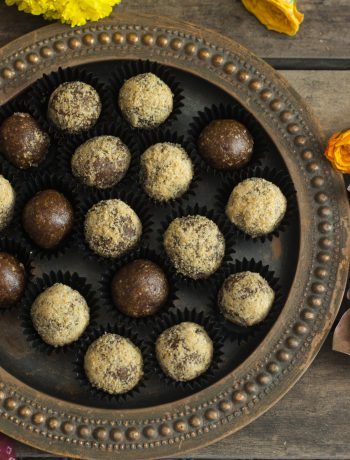
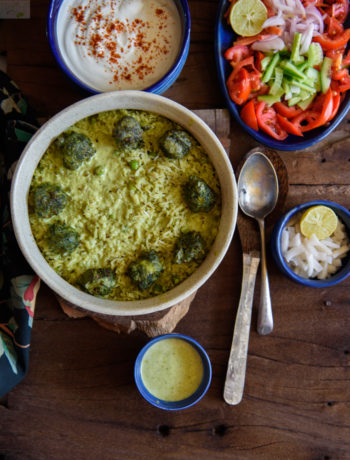
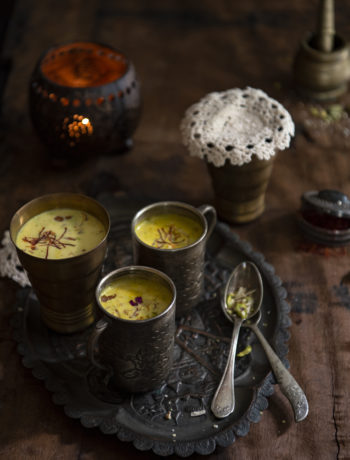
No Comments